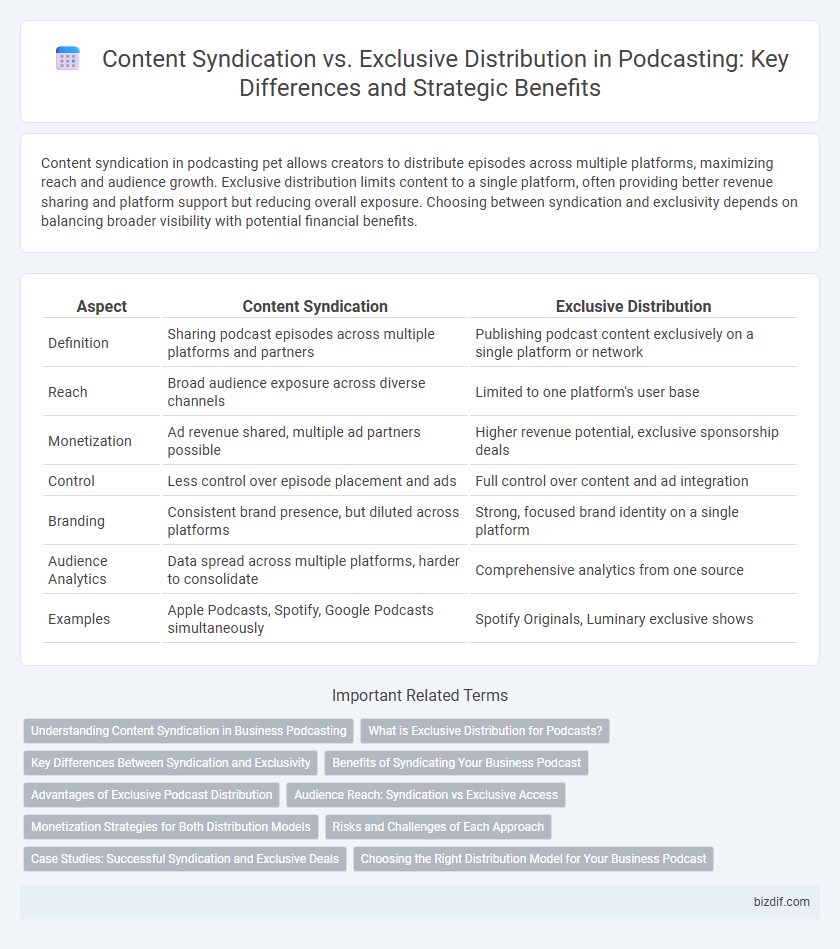Content syndication in podcasting pet allows creators to distribute episodes across multiple platforms, maximizing reach and audience growth. Exclusive distribution limits content to a single platform, often providing better revenue sharing and platform support but reducing overall exposure. Choosing between syndication and exclusivity depends on balancing broader visibility with potential financial benefits.
Table of Comparison
| Aspect | Content Syndication | Exclusive Distribution |
|---|---|---|
| Definition | Sharing podcast episodes across multiple platforms and partners | Publishing podcast content exclusively on a single platform or network |
| Reach | Broad audience exposure across diverse channels | Limited to one platform's user base |
| Monetization | Ad revenue shared, multiple ad partners possible | Higher revenue potential, exclusive sponsorship deals |
| Control | Less control over episode placement and ads | Full control over content and ad integration |
| Branding | Consistent brand presence, but diluted across platforms | Strong, focused brand identity on a single platform |
| Audience Analytics | Data spread across multiple platforms, harder to consolidate | Comprehensive analytics from one source |
| Examples | Apple Podcasts, Spotify, Google Podcasts simultaneously | Spotify Originals, Luminary exclusive shows |
Understanding Content Syndication in Business Podcasting
Content syndication in business podcasting allows episodes to be distributed across multiple platforms and channels, maximizing reach and audience engagement without limiting exclusivity. This approach enhances brand visibility by leveraging existing content to attract diverse listeners while maintaining control over original intellectual property. Compared to exclusive distribution, syndication offers scalable exposure and multiplies touchpoints with potential clients and industry partners.
What is Exclusive Distribution for Podcasts?
Exclusive distribution for podcasts refers to a content strategy where the podcast is available solely on a single platform or network, restricting access on other channels. This approach helps creators secure lucrative deals, increase platform-specific audience engagement, and maintain tighter control over content monetization and branding. Platforms like Spotify and Apple Podcasts often offer exclusive distribution agreements to attract and retain high-profile podcast content.
Key Differences Between Syndication and Exclusivity
Content syndication in podcasting allows episodes to be distributed across multiple platforms and partners, increasing reach and audience diversity. Exclusive distribution restricts podcast availability to a single platform, often driving dedicated listenership and potential revenue through unique contractual agreements. Key differences include audience control, monetization strategies, and brand positioning, with syndication prioritizing wide exposure and exclusivity focusing on targeted engagement.
Benefits of Syndicating Your Business Podcast
Syndicating your business podcast amplifies reach by distributing episodes across multiple platforms, increasing audience exposure and engagement. This strategy enhances discoverability through diverse channels, driving organic growth and attracting potential customers from varied demographics. Leveraging syndication also maximizes content lifespan and ROI by repurposing episodes without limiting availability to a single outlet.
Advantages of Exclusive Podcast Distribution
Exclusive podcast distribution ensures higher content control, enabling creators to maintain brand consistency and enforce quality standards across platforms. It often results in increased revenue opportunities through premium partnerships and subscription models, as exclusive content attracts dedicated audiences willing to pay for unique access. Furthermore, exclusivity fosters strong audience loyalty, reducing listener churn and enhancing long-term podcast growth.
Audience Reach: Syndication vs Exclusive Access
Content syndication in podcasting significantly amplifies audience reach by distributing episodes across multiple platforms and networks, tapping into diverse listener bases and maximizing exposure. Exclusive distribution limits podcast availability to a single platform, creating scarcity that can attract dedicated audiences but restricts overall reach. Syndication leverages broader accessibility for growth, while exclusive access prioritizes audience loyalty and platform-specific engagement.
Monetization Strategies for Both Distribution Models
Content syndication in podcasting expands audience reach by distributing episodes across multiple platforms, boosting ad impressions and listener conversions for diversified monetization. Exclusive distribution limits availability to a single platform, often leveraging subscription fees or premium ad placements to generate higher revenue per listener. Both models require tailored strategies: syndication maximizes volume-based income, while exclusivity focuses on creating premium, high-value listener experiences.
Risks and Challenges of Each Approach
Content syndication in podcasting risks audience dilution and loss of brand control, as episodes are widely distributed across multiple platforms which can reduce exclusivity and advertiser appeal. Exclusive distribution offers stronger brand identity and potential for premium partnerships but limits audience reach and can lead to dependence on a single platform's policies and revenue model. Both approaches present challenges in balancing audience growth with monetization strategies and maintaining content integrity.
Case Studies: Successful Syndication and Exclusive Deals
Content syndication in podcasting boosts audience reach by distributing episodes across multiple platforms, exemplified by NPR's wide syndication strategy that amplifies shows like "TED Radio Hour" to millions globally. Exclusive distribution, demonstrated by Spotify's deal with "The Joe Rogan Experience," secures unique content that drives platform loyalty and subscription growth, highlighting the value of proprietary episodes. Both models prove effective; syndication maximizes exposure while exclusivity enhances brand differentiation and monetization opportunities.
Choosing the Right Distribution Model for Your Business Podcast
Content syndication in podcasting involves distributing episodes across multiple platforms, maximizing reach and audience growth through wider accessibility. Exclusive distribution restricts content to a single platform or network, fostering deeper brand loyalty and potentially higher monetization through premium partnerships. Selecting the optimal model requires analyzing target audience behavior, revenue goals, and brand positioning to align distribution strategy with long-term business podcast objectives.
Content Syndication vs Exclusive Distribution Infographic

 bizdif.com
bizdif.com